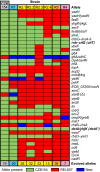Recursive genomewide recombination and sequencing reveals a key refinement step in the evolution of a metabolic innovation in Escherichia coli
- PMID: 24379390
- PMCID: PMC3926077
- DOI: 10.1073/pnas.1314561111
Recursive genomewide recombination and sequencing reveals a key refinement step in the evolution of a metabolic innovation in Escherichia coli
Abstract
Evolutionary innovations often arise from complex genetic and ecological interactions, which can make it challenging to understand retrospectively how a novel trait arose. In a long-term experiment, Escherichia coli gained the ability to use abundant citrate (Cit(+)) in the growth medium after ∼31,500 generations of evolution. Exploiting this previously untapped resource was highly beneficial: later Cit(+) variants achieve a much higher population density in this environment. All Cit(+) individuals share a mutation that activates aerobic expression of the citT citrate transporter, but this mutation confers only an extremely weak Cit(+) phenotype on its own. To determine which of the other >70 mutations in early Cit(+) clones were needed to take full advantage of citrate, we developed a recursive genomewide recombination and sequencing method (REGRES) and performed genetic backcrosses to purge mutations not required for Cit(+) from an evolved strain. We discovered a mutation that increased expression of the dctA C4-dicarboxylate transporter greatly enhanced the Cit(+) phenotype after it evolved. Surprisingly, strains containing just the citT and dctA mutations fully use citrate, indicating that earlier mutations thought to have potentiated the initial evolution of Cit(+) are not required for expression of the refined version of this trait. Instead, this metabolic innovation may be contingent on a genetic background, and possibly ecological context, that enabled citT mutants to persist among competitors long enough to obtain dctA or equivalent mutations that conferred an overwhelming advantage. More generally, refinement of an emergent trait from a rudimentary form may be crucial to its evolutionary success.
Keywords: epistatic network; experimental evolution; genetic basis of adaptation.
Conflict of interest statement
The authors declare no conflict of interest.
Figures




Comment in
-
Refining a key metabolic innovation in Escherichia coli.Proc Natl Acad Sci U S A. 2014 Feb 11;111(6):2056-7. doi: 10.1073/pnas.1323189111. Epub 2014 Jan 23. Proc Natl Acad Sci U S A. 2014. PMID: 24459186 Free PMC article. No abstract available.
References
-
- Heard S, Hauser D. Key evolutionary innovations and their ecological mechanisms. Hist Biol. 1995;10(2):151–173.
-
- Wagner A. The Origins of Evolutionary Innovations. New York: Oxford Univ Press; 2011.
Publication types
MeSH terms
Substances
Associated data
Grants and funding
LinkOut - more resources
Full Text Sources
Other Literature Sources
Miscellaneous

